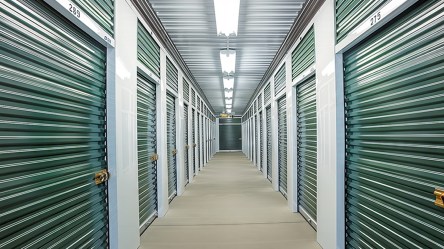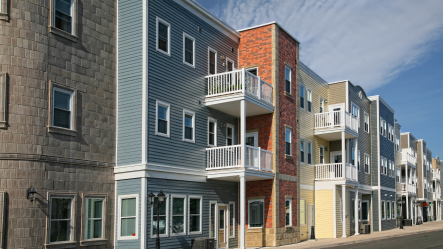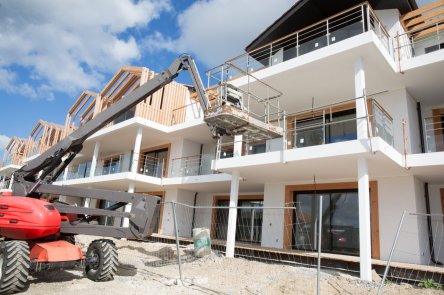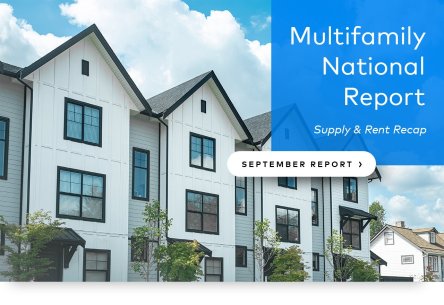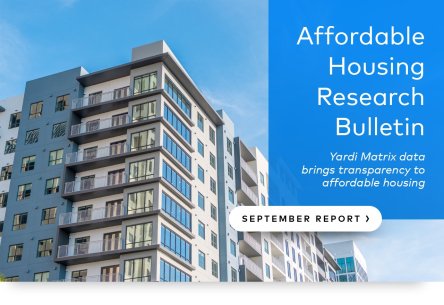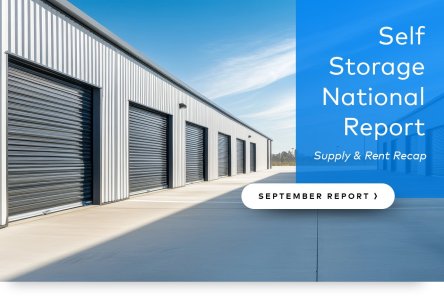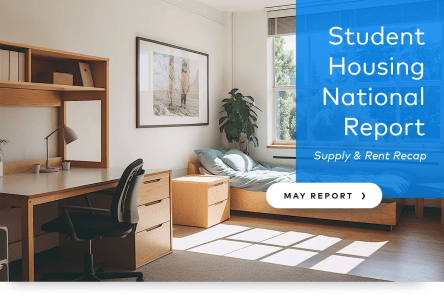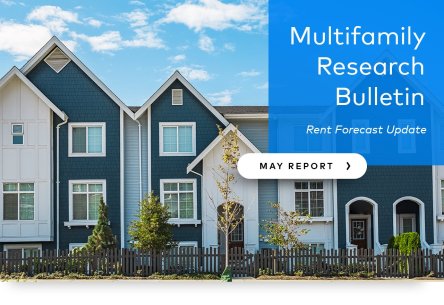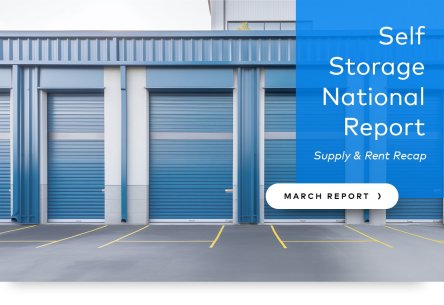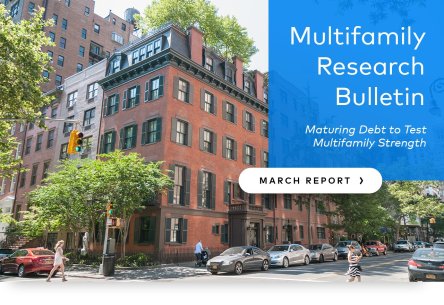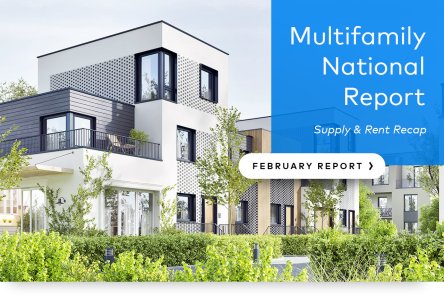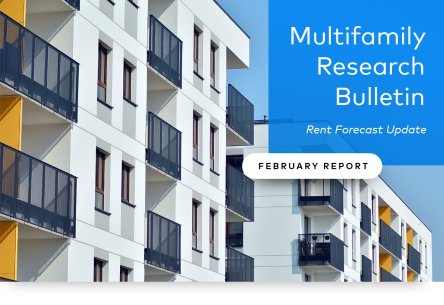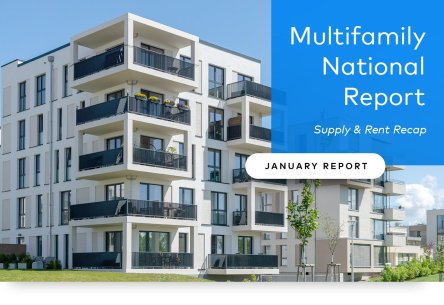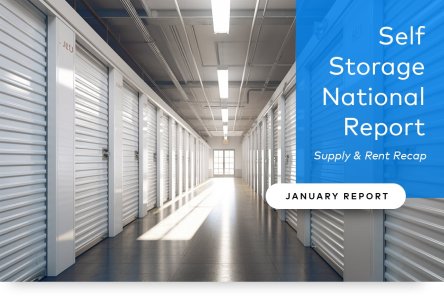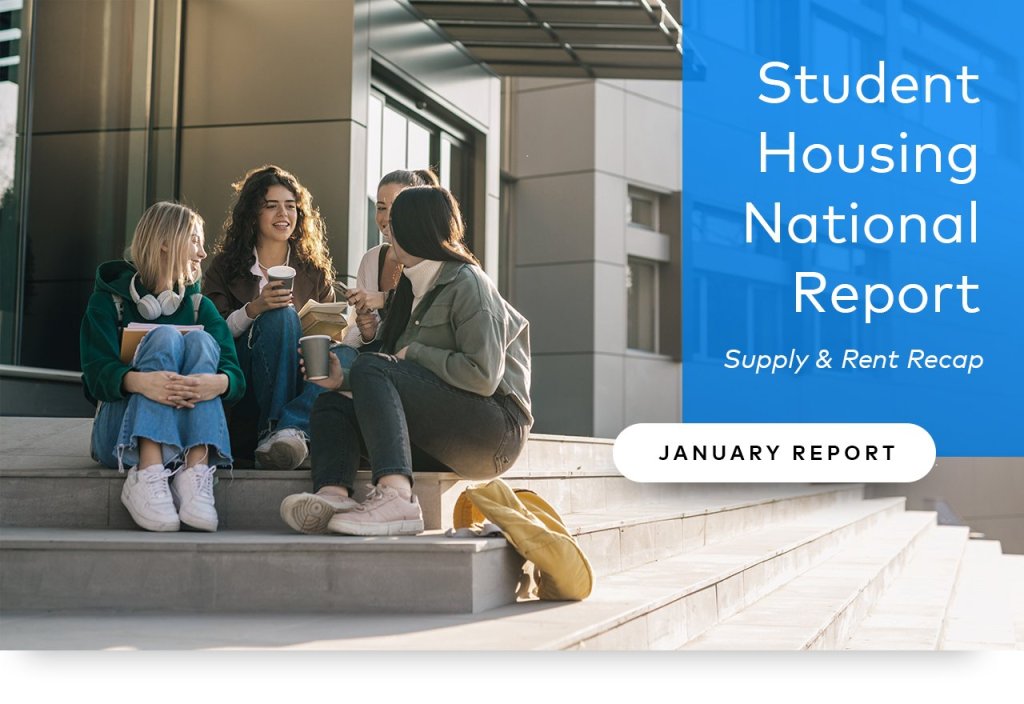A recent Yardi Matrix webinar offered perspectives on the effects of enrollment, demographics and other aspects of student housing. This is one of the markets for which Matrix provides comprehensive market intelligence. The preleasing rate of 67.1% in March indicates that “the sector is returning to normal” after two years of underperformance, according to Tyson Huebner, director of research for Matrix. While rent growth that month dropped to 2.5%, the lowest month-over-month decline in several years, the average rent per bed still reached a record high. “New supply should be a tailwind over the next few years,” Huebner said. Declines in college enrollment One key element affecting the sector is the college-age population. This group is expected to peak this year and begin a slow decline over the next five years. An even sharper decline is expected after 2030. “This will have some noticeable impacts for college enrollment and is already in evidence in some secondary and tertiary student housing markets in states like Illinois, Michigan, and Pennsylvania, where college age population has already been declining,” Huebner said. Another factor is the potential reduction in international students under changes in federal immigration policy. The impact of a reduced foreign student population remains to be seen. “The large primary state schools with big off-campus student housing markets should be concerned about the potential dip in foreign students,” Huebner said. For example, the University of Illinois is located in a state that has seen a decline in the number of high school graduates. And in fact, just 22.5% of the student body are international students. Full-time freshman enrollment outgrew total enrollment in fall 2024, representing a bright spot in the enrollment trend. Such growth “is really important, because freshmen have at least four years ahead of...
Self Storage Looks Ahead...
Yardi Matrix Webinar
The U.S. self storage industry’s dynamic landscape was the focus of a recent Yardi Matrix self storage industry update by Jeff Adler, vice president, and Tyson Huebner, director of research. The sector is emerging from two challenging years of declining rent, occupancy and revenue stemming from weak housing demand. But signs indicate that some supply and occupancy conditions are bottoming out. For example, although self storage transactions declined last year compared with 2023, activity in the second half of 2024 outpaced the same period in 2023 by 50%, generating momentum that is going to carry into 2025. “There’s a lot of capital out there available for self storage, and some large funds have been raised.” Meanwhile, year-over-year advertised rent rates improved from -4.2% in June 2024 to -1.2% in January. Real estate investment trusts involved in the sector have experienced pressures from increased property taxes, insurance and marketing costs. “Most of these companies believe that occupancy is bottoming out, or is at least stabilizing, which should give them more pricing power in 2025,” Huebner said. Absorption of supply faces resistance from demographic factors such as population growth, which measured 0.4% in 2024, down from about 1% at the turn of the century, and an anticipated reduced level of immigration. The U.S. Census Bureau and the Congressional Budget Office both project a continued drop in population growth, which will create “less demand for storage over the next few decades than in decades past,” Huebner said. “Many of the markets that have struggled the most with new supply in the past year will continue to struggle as their inventory grows. These are the same markets that rely on migration and population growth to absorb that new supply,” he added. Reasons for both concern & optimism Only...
Reaching a Peak
New Matrix Affordable Housing Report
Affordable housing completions are set to peak this year, then fall in 2026, according to a new national report from Yardi Matrix. The 78,377 units of affordable housing deliveries projected for this year would exceed by 12.6% the 69,596 registered in 2024. However, deliveries in 2026 could total no more than 64,745 units, according to the report. Factors driving the anticipated decline include the costs of land, labor and materials; rising insurance premiums; labor shortages; and delays in entitlements. “As costs rise, the same amount of subsidies produces fewer units. And the longer it takes to build, the fewer units get delivered,” the report notes. “The need for affordable housing has accelerated in recent years, and that is not likely to change as interest rates remain high and construction of for-sale housing lags historical levels. Despite that demand, the decline in starts signals fewer affordable multifamily deliveries in the years following 2025,” adds Paul Fiorilla, director of research for Yardi Matrix. The report also notes that with market rate apartment starts registering their lowest number since 2013, affordable multifamily construction is increasing as a share of all multifamily development activity. California, Texas and Florida lead the nation in affordable multifamily stock and development. Yardi Matrix’s affordable database encompasses more than 25,000 fully affordable properties comprising more than 3.3 million units. See the new national affordable housing report for more about key trends in the...
Emerging Trends
Detailed in Industry Report
The 46th edition of trends and forecast publication Emerging Trends in Real Estate® is out. Compiled by PwC and the Urban Land Institute, this report details trends in real estate investment and development, finance and capital markets, property sectors and other key issues in the U.S. and Canada. The report incorporates contributions from Yardi Matrix and CommercialEdge. building and cranes under construction against blue sky Here are excerpts from the report: Multifamily: Focus on affordability Supply will dominate apartment market conversations in 2025. Some experts remain bullish on the prospect of ongoing strong demand over the next few years due to strong job growth, favorable demographics, immigration, the high cost of homeownership and the lack of single-family inventory. However, a growing number of renters are cost burdened, underscoring the need for more market-rate and affordable supply. Industrial: Demand lags supply When the pandemic prompted a dramatic surge in online shopping, the industrial sector experienced a significant shortage of warehouse and third-party logistics facilities. Developers responded with record construction. More than 1 billion square feet of new product was added in the last two years alone, far exceeding prior records. Net absorption has been positive, but demand has not kept pace with new supply, so the amount of vacant space continues to grow. Retail: In rebound mode Few foresaw the strong rebound in demand for physical retail space that occurred following the 2020 pandemic year and drove retail vacancy rates below levels not seen in more than a decade. The number of distressed chains either liquidating or seeking debtor protection increased more than 50% in 2024. “Thus, while retail sales have remained in positive territory since 2020, the impacts of the recent inflationary wave and resultant money tightening policies have taken a toll,” but “overall...
Student Housing Update
From Yardi Matrix
The student housing market is showing promising signs as it heads into the very early days of a new leasing season. Despite some challenges, the outlook remains positive, according to the latest webinar on the sector from Yardi Matrix. (View recording and other materials here.) Student housing continues to see solid demand and a few market adjustments should benefit the sector in the medium term. Yardi Matrix tracks the performance of 1.15 million student housing beds at over 2500 U.S. universities to analyze the performance of the student housing market. Let’s dive into some of the key points shared by Tyson Huebner, Director of Research for Yardi Matrix, which explore current state of the student housing market and actionable investment insights. Rent Growth Trends Huebner kicked off the discussion with an optimistic view of the student housing sector, driven by early enrollment data from around half of the Yardi 200 markets. While student housing occupancy has dipped slightly from last year’s 95.4 percent to 93.9 percent, it still reflects strong demand, especially when compared to the pre-pandemic occupancy levels of 96.1 percent. The decrease in occupancy is attributed to a few underperforming markets, but overall, the demand remains robust. Rent growth in the student housing sector has moderated slightly but still averaged a healthy 6% during the leasing season, down from the previous year. This deceleration is partly due to the slower growth in the broader multifamily sector, which has influenced student housing. However, there are still several markets showing exceptional rent growth, highlighting the importance of understanding local market dynamics. As with any cyclical industry, volatility remains a key characteristic of the student housing market. Huebner emphasized the importance of diversifying portfolios, as some markets that were previously underperforming have seen a dramatic turnaround, showcasing the unpredictable nature of supply and demand. The key takeaway here is that market data and deep local knowledge are essential for successful investments in this sector. Insights and Investment Opportunities Looking ahead, Huebner shared several promising investment themes that continue to hold strong: Declining New Deliveries: One factor contributing to the favorable outlook is the reduction in new student housing deliveries, which should help balance supply and demand in the coming years. Diversified Markets: Of the 200 markets tracked, 41 reached 99% occupancy or higher, and 35 saw double-digit rent growth. At the same time, 22 markets had occupancy rates below 85%, and 23 markets experienced rent declines. This highlights the sector’s inherent volatility and the importance of market selection. Overlooked Opportunities: There are still many opportunities in overlooked markets, especially at secondary and tertiary schools that may be under-supplied. Huebner pointed out several key areas for investment, including: 15 primary state schools with no new supply 34 schools with less than 35% of total enrollment housed in student housing 45 schools that have seen significant recent enrollment growth (over 2,000 students) “This sector, even though it’s 20 years old, has been growing. There’s still a lot of growth left in it, not only on the acquisition of getting the on the acquisition side, but in the development business,” said Jeff Adler, vice president of Yardi Matrix. Despite some challenges, there are numerous high-performing markets and overlooked opportunities for investors who understand the volatility and dynamics at play. By leveraging market data and diversifying portfolios, student housing investors can continue to capitalize on the sector’s strengths and navigate its challenges. Yardi Matrix data can help. Learn more...
Risks and Rewards
Yardi Matrix Multifamily Webinar
Yardi Matrix vice president Jeff Adler again delivered a master class on the current state of the multifamily sector during an Oct. 23 webinar. The recording and presentation slides are available to view online. Multifamily is experiencing robust performance despite a significant influx of new supply, particularly in the Sun Belt and Mountain West regions. Although advertised asking rent growth for new leases has softened—often turning negative—units are still being absorbed. Overall, most markets are experiencing a healthy three to five percent growth in both occupancy and renewals. “The multifamily industry has really performed quite well given the unbelievable amount of new supply that’s been coming in,” Adler said. In the top 20 markets tracked by Matrix analysts, the multifamily sector is grappling with substantial new supply, with approximately half a million units set to be delivered this year. Renter-by-necessity units (Class B to C assets) are now outperforming lifestyle units (Class B+ to A assets). This is largely due to the nature of new construction, which tends to cater to the higher end of the market. This has led to some challenges for owners of lifestyle properties, as the influx of new supply dampens their performance. Retention rates are returning to pre-pandemic levels, largely driven by affordability issues in the single-family home marketplace. This trend suggests that many renters are opting to stay put, contributing to a higher number of positive renewal lease trade-outs, even in markets experiencing rent declines. This trend highlights the critical role housing affordability plays in the current market landscape. Adler discussed some of the specific challenges for affordable housing supply in great detail – tune in to the recording for more insights. The bottom line is that more housing will need to be constructed to resolve the nation’s affordable housing problem. Fewer new stock deliveries are expected in 2026 and 2027, which means the stage may be set for a potential spike in multifamily rent growth, Adler forecast. An overarching shortage of U.S. housing is unlikely to improve in the next five to ten years, suggesting a strong investment thesis for multifamily housing. As capital costs normalize, transaction activity is expected to increase. While some distress may appear in specific areas, the multifamily sector remains resilient and poised for continued long-term growth. In a new format for Matrix, the webinar also included identification of potential investment opportunities and a comprehensive look at the state of the economy. Listen to learn more. “The economy is pretty healthy at a macro level. But there are cracks in the economy emerging, and at some point, those cracks have to come to fruition and be resolved,” Adler...
Multifamily Update
From Yardi Matrix
Seasonality and supply are tempering advertised asking rent growth but demand remains strong, according to the latest Yardi Matrix National Multifamily Report. The average U.S. advertised asking rent decreased by $3 in September to $1,750, flat at 0.9 percent year-over-year (YoY). Occupancy stood at 94.8 percent in September, unchanged YoY. Gateway markets in the East and secondary markets in the Midwest continue to lead in YoY advertised asking rent growth, run by New York City (5.4 percent), Kansas City (4.2 percent) and Boston (3.4 percent). Supply increases continue to pressure asking rents in many Sun Belt metros, and the largest declines YoY were posted by Austin (-4.9 percent), Raleigh (-3.1 percent) and Phoenix (-2.4 percent). Post-pandemic demand has led to 1.7 million multifamily units absorbed between March 2020 and August 2024. All 132 markets surveyed experienced positive absorption, with Dallas (108,000 units) and Houston (71,000 units) in the lead. Single-family rentals advertised asking rents decreased $3 in September to $2,167, for a 0.6 percent YoY increase, with Kansas City (4.7 percent YoY) and Indianapolis (4.3 percent) posted the strongest growth. SFR occupancy declined 30 basis points to 95.3 percent in August. Gain more insight in the new Yardi Matrix National Multifamily Report. Yardi Matrix offers the industry’s most comprehensive market intelligence tool for investment professionals, equity investors, lenders and property managers who underwrite and manage investments in commercial real estate. Yardi Matrix covers multifamily, affordable housing, student housing, vacant land, industrial, office, retail and self storage property types. Email [email protected], call 480-663-1149 or visit yardimatrix.com to learn...
Affordable Housing
New Yardi Matrix report
The need for additional affordable housing inventory is a foundational issue for the market, a new Yardi Matrix Research Bulletin on the affordable housing sector shows. With an increasing number of households being designated as “cost burdened” across earning brackets, policymakers are pushing for more affordable stock, with an expected 69,600 units set to come online in 2024. A multi-year peak for the sector is anticipated with the 70,500 units projected for delivery in 2025. However, a looming slowdown in new inventory after 2025 could exacerbate the problem. The primary challenge facing governments and renters alike is that market rate housing is not competitive with affordable housing in many of the country’s major metros, including markets such as Chicago, San Francisco, Los Angeles, Boston, Miami and Northern New Jersey. In San Francisco (where the market-rate average is $3,028 and fully affordable average is $1,982) or Boston (where the market-rate average is $2,801 and fully affordable average is $1,819), there is a big gap between market-rate and fully affordable rents. Conversely, at least 90 percent of market-rate stock is competitive with affordable properties in seven small markets, including South Dakota; Wichita, Kan.; Huntsville, Ala.; Amarillo, Texas; Des Moines, Iowa; Fayetteville, Ark.; and Omaha, Neb. The Yardi Matrix study is based on a dataset containing over 3.3 million units in 20,000 fully affordable housing properties. These properties are owned and operated by both private sector entities and non-profit organizations. The study compared the average maximum allowable rent of fully affordable units owned by private entities with the average advertised rent of market-rate units, broken into four levels of apartment quality. Review the levels and income required for affordability of each type in the report. In addition to the competitiveness disparity, supply growth limitations and composition of total housing...
Self Storage Update
From Yardi Matrix
Despite the uncertainty fueled by declines in advertised asking rental rates, investor interest remains high for acquisition and development, depending on seasonal patterns as well, according to industry data contained in the latest Self Storage National Report from Yardi Matrix. The annualized same store advertised asking rate reached an average of $16.31 nationally in August 2024. That is a 4.3 percent decrease on a year-over-year (YoY) basis. This is the 23rd consecutive month of declines. All top metros tracked by Yardi Matrix saw negative movement in advertised asking rents in August. Combined same-store advertised asking rents for non-climate-controlled units and climate-controlled units decreased YoY. Rates for larger units are faring better than those for smaller units in almost all metros. Yardi Matrix tracks a total of 3,408 self storage properties in various stages of development, including 837 under construction, 2,063 planned and 508 prospective properties. Yardi Matrix also maintains operational profiles for 32,142 facilities, bringing the total data set to 35,550. Gain more information on the performance of the self storage sector. Yardi Matrix offers the industry’s most comprehensive market intelligence tool for investment professionals, equity investors, lenders and property managers who underwrite and manage investments in commercial real estate. Yardi Matrix covers multifamily, affordable housing, student housing, vacant land, industrial, office, retail and self storage property types. Email [email protected], call 480-663-1149 or visit yardimatrix.com to learn...
Self Storage Status
Trends and insight from Yardi Matrix
As we move through 2024, the self storage market is navigating a complex landscape shaped by a mix of persistent challenges and emerging opportunities. Yardi Matrix experts Jeff Adler and Tyson Huebner recently delivered an update on the industry’s current state in a webinar (available for download here), drawing on recent data and trends to offer a clearer picture of what’s happening in the self storage sector.The self storage market has faced significant headwinds over the past year. Despite the typically bustling summer season, performance has remained underwhelming. Home sales—a key driver of occupancy and rent growth during the pandemic—are at their lowest in nearly two decades. This downturn has translated into declining revenue and net operating income (NOI) growth for self storage Real Estate Investment Trusts (REITs). “Advertised asking rent rates have been falling year over year for almost two years, with a decline of 4.1 percent recorded in July. Although this represents a slight improvement from previous months, the overall trend remains negative,” said Huebner, research director for Yardi Matrix. On the supply side, there is some positive news. The delivery of new units is finally trending downward, with 2024’s expected deliveries being nearly 10% lower than those in 2023. This reduction in new supply should alleviate some pressure on the market and help stabilize conditions. “Looking ahead to 2025, the reduction in new supply could help support growth, and there is optimism that a potential drop in mortgage rates might boost home sales and, by extension, demand for self storage,” Huebner said. There are emerging signs that the market may be nearing a turning point. For the first time in nine quarters, average rent and occupancy rates have shown relative stability year over year. This stabilization, which began in Midwestern, Northeastern,...
Preleasing Progress
Yardi Matrix Reports
Surveyed preleasing at colleges and universities tracked by Yardi® reached 85.2 percent in June, on par with last year’s pace and outpacing historic trends. The average advertised asking rent per bed stood at $898 last month, while year-over-year rent growth slowed to five percent, according to the latest Yardi Matrix National Student Housing Report. Averaging 6.1 percent asking rent growth for the season since October 2023, the Fall 2024 school year is shaping up to be one of the best for the student housing sector. During the summer months, the pace of preleasing has slowed. Additionally, issues with FAFSA filing and processing pose a concern for near-term enrollment growth. Nevertheless, 39 universities were at least 94 percent preleased already, including 13 schools that reached at least 99.7 percent preleased. A total of 41 universities posted double-digit rent growth in June. Large primary state schools like Tennessee and Purdue had the strongest rent growth. Smaller institutions such as Vermont (16.7 percent rent growth), San Jose State (15.8 percent), Oregon State (15.8 percent) and New Hampshire (15.6 percent), also stand out. “Rent growth is most significantly impacted by preleasing and enrollment trends. The top four schools for rent growth were on average 93.4 percent preleased and experienced 4.7 percent enrollment growth in 2023, versus the bottom four which average 67.4 percent preleased. Gain more insight in the new Yardi Matrix National Student Housing Report. Yardi Matrix offers the industry’s most comprehensive market intelligence tool for investment professionals, equity investors, lenders and property managers who underwrite and manage investments in commercial real estate. Yardi Matrix covers multifamily, affordable housing student housing, vacant land, industrial, office, retail and self storage property types. Email [email protected], call 480-663-1149 or visit yardimatrix.com to learn...
Creating Opportunity
Yardi Matrix Multifamily Webinar
Yardi Matrix hosted its Q2 2024 Multifamily Webinar this week, providing more than an hour of useful insight and analysis on rent performance, supply dynamics and opportunities for investment in the sector. Miss Jeff Adler’s insight? View the presentation recording or review the slide deck on the Yardi Matrix website. The latest Matrix monthly multifamily report can also be found here. The average U.S. asking rent gained $6 to $1,725 in April, up 0.7 percent year-over-year. Meanwhile, occupancy remained at 94.5 percent in March, a rate it has held since the beginning of the year. “All things considered, March and April were positive months from a seasonal standpoint, April is right in line with (a typical) seasonal uplift in rents,” said Adler, vice president of Yardi Matrix. Topline webinar takeaway: rental market performance currently varies by region, with factors such as supply response, job growth, and regulatory issues playing critical roles. And while rents for “renter by necessity” properties have increased, margins have not necessarily followed suit due to rising expenses, especially insurance. Regional trendlines include the Southeast, where rents are decreasing due to a high volume of new supply. In the Midwest, there are more modest completions and good rent growth, making it an attractive option for portfolio diversification. Cincinnati, Omaha and Lexington led year-over-year rent growth last year. Columbus, Louisville and Dayton are also performing well in 2024. More generally, select tertiary markets are performing well because job growth is driving demand without a significant supply response. Madison, Louisville, Milwaukee and Grand Rapids top that list, supporting the strong performance of the Midwest overall. In addition to a thorough look at the state of the U.S. economy (food for thought: household sentiment doesn’t align with the generally positive perspective presented by the...
Student Housing
Yardi Matrix update
Preleasing at Yardi 200 schools reached 73.5 percent in April, exceeding last year’s rate by 50 basis points, while rent growth stood at 5.5 percent, according to the latest Yardi Matrix National Student Housing Report. As of April, the average rent reached $895 per bedroom, unchanged from the previous month and 5.5 percent higher year-over-year. Similar to the preleasing rate’s evolution, rent growth has slowed from the beginning of the leasing season, but is still above the average growth rate of 3.5 percent. Rent growth slowed from 6.8 percent early on in the leasing season and has averaged six percent throughout the leasing season to date. A total of 35 U.S. markets saw double digit rent growth, while 23 posted rent declines. State schools across the Sun Belt with growing enrollments have seen the biggest jumps in rents. Preleasing has lately been trending in line with last year. A total of 19 schools were at least 90 percent preleased as of April, including Ole Miss (100 percent), Kentucky (93.3 percent), Purdue (93 percent) and James Madison (92.5 percent). But 22 universities didn’t reach a 50 percent preleasing rate, such as UT–Arlington and Georgia State. “Strong rent growth is indicative of solid demand for product and consolidation of higher education into the largest student housing markets, as primary state schools have been able to outgrow their peers,” state Matrix analysts. Student housing investment has been on par with last year, with 18 properties changing hands year-to-date through April. The average price per bed stood at $100,857—well ahead of previous years. Gain more insight on leasing, rents and investment in the new Yardi Matrix National Student Housing Report. Yardi Matrix offers the industry’s most comprehensive market intelligence tool for investment professionals, equity investors, lenders and property managers...
Rent Forecast
New from Yardi Matrix
The multifamily market is a tale of two supply scenarios, shows a new special report from Yardi Matrix. Of the 134 U.S. cities reviewed by Yardi Matrix, those that recorded substantial growth during the pandemic and are now receiving high volumes of new supply are posting stagnant or falling rents. Nine of 20 markets that saw rents fall since the beginning of the year are in Florida or Texas. Other pandemic high-growth markets like Atlanta, Raleigh-Durham and Salt Lake City are also experiencing lower average asking rents than a few months ago. Secondary markets in the Midwest, Northeast and South are still posting strong growth in asking rents. Markets with increases higher than two percent include Albany; Milwaukee; Worchester-Springfield; Louisville; Cincinnati; Des Moines; Richmond; Madison; Lafayette, Ohio; Youngstown; Providence; Northern Virginia; Portland, Maine; and Scranton-Wilkes-Barre. Honolulu, where supply is a consistent challenge, marked 5.7 percent growth year-to-date. “We still expect markets with lots of supply to continue to struggle to realize gains this year, but that is only a supply issue, and once those new units get absorbed all of those markets will be back in good shape,” notes the report. Rent growth in 2025 will be stronger than this year, and in 2026 even more so, as the current influx of supply to be fully absorbed. Gain more insights in the latest Multifamily Rent Forecast Update from Yardi Matrix. Yardi Matrix offers the industry’s most comprehensive market intelligence tool for investment professionals, equity investors, lenders and property managers who underwrite and manage investments in commercial real estate. Yardi Matrix covers multifamily, student housing, vacant land, industrial, office, retail and self storage property types. Email [email protected], call 480-663-1149 or visit yardimatrix.com to learn...
Opportunity and Volatility
Student Housing Webinar Recap
Student housing remains a resilient sector with promising long-term growth prospects, attracting significant capital despite ongoing challenges, according to the latest Yardi Matrix webinar held Thursday. Find the full recording here and find the presentation slides here. However, investors navigating the student housing market require a nuanced understanding of its unique dynamics and the ability to identify opportunities amid volatility. As of March, the average rent reached $895 per bedroom, marking an all-time high for the sector. A total of 41 universities tracked for the Yardi Matrix National Student Housing Report had double-digit rent growth. “Long term sector growth is good. This is going to continue to attract capital, particularly in light of what we expect to be ongoing struggles in many of the markets in multifamily. And you’ve got to really kind of pick the winners,” said Jeff Adler, vice president of Yardi Matrix. Student housing can offer savvy investors higher returns but comes with inherent volatility, characterized by fluctuating performance among different schools. Examples include colleges like Ole Miss and Mizzou, which showcase how poorly performing schools can experience a strong rebound, while previously successful institutions like the University of Nevada, Reno, may face challenges due to oversupply. “There’s inherent lumpiness, or volatility, in the financial performance because supply tends to come in not evenly, but in large chunks and needs to get absorbed,” said Adler. “As you think about performance at a school, you need to see through those cycles, and/or you can actually use those points as opportunities to buy or sell if you know where the timing is going to hit.” Success in student housing hinges on a diversified portfolio across markets and strategies, not solely reliant on enrollment or rent growth metrics. Data-driven insights from Yardi Matrix help set realistic expectations and navigate short-term volatility while focusing on long-term fundamentals. The student housing sector is relatively young, with ample opportunities for development, rehabilitation, and value-added strategies. “One of the things I have taken away is just how young this industry is. (Around) 80 percent of the inventory is less than 25 years old, which means that there are still opportunities to develop a rehabbed value-added sector and an acquisition strategy,” Adler said. “The primary strategy in the sector has been new development, and that makes a lot of sense, but there are other strategies emerging as this industry begins to age.” Such strategies involve developing or acquiring properties near flagship state schools, emphasizing demographic trends and acceptance rates. Value-add strategies target slower-growth schools with potential for improvements or strong barriers to new supply. Opportunistic approaches involve timing markets based on supply and demand waves, with considerations for market characteristics and regulatory risks. With careful planning and informed decision-making, investors can unlock the full potential of this dynamic and resilient sector. View the full event recording with many more student housing investment insights, and get even more data from the latest Yardi® Matrix National Student Housing...
Self Storage
Faces Headwinds
The self storage real estate sector is facing headwinds and continues to be affected by current market conditions, according to the latest Self Storage National Report from Yardi Matrix. Annual street rate growth was still negative in February. The average annualized same-store asking rent per square foot for combined mix of unit sizes reached an average of $16.37 nationally last month, marking a 3.6 percent decrease on a year-over-year basis. All top metros registered a negative street rate on an annual basis in February. Combined same-store rates for non-climate-controlled units and climate-controlled units decreased in all the top metros tracked by Yardi Matrix on a year-over-year basis. “There is hope that a turnaround in the housing market later this year or early 2025, contingent on interest rates cuts, could unlock pent-up demand for housing and migration, thus fueling demand for self storage,” say Matrix analysts. Investors are showing precaution due to market uncertainty. Nevertheless, despite the impact of high interest rates, there is still interest in self storage development. Yardi Matrix tracks a total of 5,148 self storage properties in various stages of development, including 880 under construction, 2,031 planned, 592 prospective, 1,546 abandoned and 99 deferred properties. Yardi Matrix also maintains profiles for 30,294 operational facilities, bringing the total dataset to 35,442. Gain more insight on the performance of the self storage sector. Yardi Matrix offers the industry’s most comprehensive market intelligence tool for investment professionals, equity investors, lenders and property managers who underwrite and manage investments in commercial real estate. Yardi Matrix covers multifamily, student housing, vacant land, industrial, office, retail and self storage property types. Email [email protected], call 480-663-1149 or visit yardimatrix.com to learn...
Student Housing
Pre-leasing gains more ground
Last month, the average student housing preleasing rate for Yardi 200 schools reached 61.5 percent, marking a 450-basis-point increase year-over-year, according to the latest Yardi Matrix National Student Housing Report. The market is healthy enough to absorb 46,000 new beds coming online, with demand fueled by enrollment growth. The average rent per bed reached $883 in February, showing a 5.2 percent increase since the same period last year. Year-over-year rent growth was down from the 6.7 percent recorded in October 2023. A total of 16 universities were more than 80 percent preleased, including larger student markets like Ole Miss (98.7 percent), Purdue (88.7 percent), Tennessee-Knoxville (87.5 percent), Virginia Tech (87.2 percent) and Arkansas (86.8 percent). Only 35 schools were less than 40 percent preleased, compared to 47 percent in February 2023. “Rent growth slowed each month of the leasing season but is well-above the average of 3.5 percent going back to the beginning of 2018, and well ahead of the general multifamily market, as student housing has proven to have much different demand drivers,” note Matrix analysts. Enrollment data collected from 178 universities shows that total enrollment was up 0.8 percent on a year-over-year basis, marking a significant increase from the -0.3 percent recorded in Fall 2022. Yardi Matrix forecasts that 46,285 new beds will come online in 2024, improving considerably on the 35,610 beds delivered in 2023. Gain more insight in the new Yardi Matrix National Student Housing Report. Yardi Matrix offers the industry’s most comprehensive market intelligence tool for investment professionals, equity investors, lenders and property managers who underwrite and manage investments in commercial real estate. Yardi Matrix covers multifamily, student housing, vacant land, industrial, office, retail and self storage property types. Email [email protected], call 480-663-1149 or visit yardimatrix.com to learn...
Multifamily Debt
Maturing Loans Test Sector
The multifamily market has 58,533 properties with loans set to mature over the next five years, representing $525 billion of the total $1.1 trillion of loans currently backed by apartments, according to a new special report from Yardi Matrix. Metros with the largest volume of maturities include Atlanta ($34.9 billion), Dallas ($26.6 billion), Denver ($22.9 billion), Houston ($20.8 billion), New York ($19.9 billion) and Chicago ($18.8 billion). Markets with the highest percentage of loans coming due through the end of 2029 are Atlanta (65.9 percent), Denver (56.9 percent), Nashville (56.2 percent), Las Vegas (55.9 percent), Houston (53.6 percent) and Chicago (53.2 percent). More than half of the multifamily loans found in Yardi Matrix’s database, $641.8 billion (56.3 percent) was originated by Fannie Mae and Freddie Mac. Next in line, at $187.3 billion (16.4 percent) came from commercial banks, followed by the federal government/HUD ($115.7 billion, 10.1 percent), debt funds (69.9 billion, 6.2 percent), life companies ($67.6 billion, 5.9 percent) and CMBS ($25.2 billion, 2.2 percent). “Multifamily originations peaked during years with record transaction volume, including 2021 (when $194.7 billion of loans were originated) and 2022 ($209.8 billion), as investor demand reached a high point during a time of strong fundamental performance and low interest rate,” note Matrix analysts. Of the loans in the database, $61.8 billion are set to mature in 2024, with another $84.3 billion in 2025, $89.3 billion in 2026, $77.9 billion in 2027 and $107.3 billion in 2028. By percentage, 5.4 percent of the loans will mature by the end of this year, 12.8 percent by the end of 2025, 27.5 percent by the end of 2027 and 46.1 percent by the end of 2029. Markets with a high percentage of loans maturing over the short term and recent negative rent growth include...
Rents Vary Regionally...
Reports Yardi Matrix
National asking rents posted their first increase in over seven months in February, according to the latest Yardi Matrix National Multifamily Report. The average U.S. asking rent rose $1 to $1,713 in February, up 0.6 percent year-over-year (YoY), while occupancy decreased 60 basis points YoY to 94.5 percent as of January. Markets in the Northeast and Midwest continued to register rent increases, in contrast to rent contractions in high-supply Sun Belt markets. Of Yardi Matrix’s top 30 metros, 13 posted rent declines, and five were down by three percent or more YoY. Occupancy was positive only in San Francisco, up 0.1 percent. While rents generally show signs of stability, factors including supply, demand, regional metrics and affordability will determine the market’s 2024 performance. Occupancy is likely to continue to decline, with one million new rental units expected to come online through the end of 2025. Already, heavy deliveries in Sun Belt and Southwest metros have eroded rent growth, with more construction underway. “While high-demand markets are likely to record weak rent growth over the next year or two, the seeds of a rebound have been planted, as starts are declining and deliveries will drop in 2026 and 2027,” states the report. Single-family rents declined $2 in February to $2,133, equating to a 1.2 percent year-over-year increase. Single family occupancy remained flat at 96.5 percent in January. High mortgage rates and the scarcity of for-sale assets continue to boost demand. Gain more insight in the new Yardi Matrix National Multifamily Report. Yardi Matrix offers the industry’s most comprehensive market intelligence tool for investment professionals, equity investors, lenders and property managers who underwrite and manage investments in commercial real estate. Yardi Matrix covers multifamily, student housing, vacant land, industrial, office, retail and self storage property types. Email [email protected], call...
Self Storage May Struggle
As Fewer Americans Move
The latest Yardi Matrix Self Storage webinar provided insights into the current state of the economy and its impact on the self-storage industry. Find a full recording of the March 6 webinar here and view the presentation deck here. The self storage sector began seeing weaker performance in 2023 due to a decline in demand, primarily caused by low home sales (due to high interest rates) and subsequent reduced mobility nationwide. There has been a 25 percent reduction in state-to-state migration compared to 2021 and 2022. Consequentially, self storage revenue growth was nearly flat last year, driven by declining occupancy and decelerating street rent growth. Find the most recent monthly report on the self storage sector from Yardi Matrix. A near term expansion in self storage supply is forecast, while the coming years are expected to show an overall inventory decrease. Jeff Adler, vice president of Yardi Matrix, mentioned new rental strategies employed by REITS that keep street rents low and quickly moving vacant spaces, impacting same-store rent growth negatively. Despite construction and completions remaining steady, same-store rent growth was -3 percent in January. Adler discussed the current state of the market, highlighting that occupancy and rent increases during the pandemic pushed same-store sales revenues up by 37 percent. However, same-store occupancies have now declined to pre-COVID levels, hovering around 90 percent, and the decline in street rents is affecting overall revenues. Matrix analysts believe that that the sector may not see a significant performance improvement until home sales recover, expected in late 2024 or early 2025. “I think an improvement really doesn’t happen until home sales happen, which means the for-sale market opens up and that means (lower) interest rates, and that’s later in 2024, maybe early 25,” Adler said. However, potential opportunities in self storage are not unheard of. Locations where supply pressures were putting downward pressure on street rents, such as Orlando, Tampa, and Atlanta. Markets that experienced declining supply over the past few years, like New York, Denver, and Minneapolis, are considered to be on the mend. “These are places that really were hit hard a few years ago. But supply is waning. So they’re the first to kind of bounce, and I would say there are opportunities for stressed or distressed properties, you know, acquired in 2021 and 22 or developed in 2023,” Adler said. Gain more insight on the state of the economy as a whole and projections for the housing market by listening to the webinar...
Rent Forecast Update
From Yardi Matrix
Multifamily asking rents broke the five-month streak of sequential average declines in January, rising 0.07 percent, shows a new special report from Yardi Matrix. Of the 142 markets tracked, last month 61 posted declines, 71 marked increases and 10 remained flat. Largest increases continued to occur in midsize cities in the Northeast and South, including in White Plains, NY; Buffalo, NY; Birmingham, AL; Worcester-Springfield, MA; and Columbus, GA. The largest decreases were consistent in Western markets and Florida. On a national level, by asset class, rents in the Renter-by-Necessity (RBN) segment rose 0.08 percent, outperforming Lifestyle (0.04 percent). The strongest performers in RBN rents, with MoM growth of over 1 percent, were 11 midsize cities in the South and Northeast and four markets in the West. In the Lifestyle segment, 14 markets posted MoM growth greater than 1 percent, 10 of which were in the South or Midwest and four scattered far from Northeast—Honolulu, the Inland Empire, Miami and the Central Coast. “Overall performance in asking rents in January was remarkably strong for a month that is generally very weak and often negative, and we expect the trend of RBN rents performing better than Lifestyle rents to continue throughout the year,” say analysts. The strong job reports and improving consumer confidence have pushed the expected mild recession to the end of this year or beginning of the next year. This has also impacted Yardi Matrix’s national forecast for 2024, up from 0.8 percent to 1.8 percent, but the substantial influx of supply expected to come online this year will dampen rent growth in many of the larger Sun Belt markets. Read the latest Multifamily Rent Forecast Update from Yardi Matrix. Yardi Matrix offers the industry’s most comprehensive market intelligence tool for investment professionals, equity investors, lenders and...
Rents Remain Flat
Yardi Matrix Update
The multifamily market was stable at the start of 2024, despite the pressure of a supply boom in some markets, according to the latest Yardi Matrix National Multifamily Report. The average U.S. asking rent remained flat at $1,710 in January for a 0.5 percent year-over-year increase, while occupancy decreased 50 basis points year-over-year in December, to 94.6 percent. Rent growth remained highest in the Northeast and Midwest, while four of Yardi Matrix’s top 30 metros posted rent declines of three percent or more year-over-year. Occupancy was positive in one market and remained flat in two. Rent growth will be impacted by supply in 2024, as Yardi Matrix forecasts a record 540,000 units to be delivered this year, and another 460,000 units in 2025. “Another year of weak growth is expected in 2024 largely due to the rapid increase in deliveries that stems from the sector’s strong performance, high liquidity, and favorable treatment in the 2017 tax bill,” say Matrix analysts. New supply is inconsistent across the map, with the highest amounts in fast-growing tertiary and secondary markets, predominantly in the Sunbelt and Western regions. There, rent growth will likely remain tepid. Meanwhile, the weak supply in markets in the Northeast and Midwest is expected to keep rents rising. Single-family rentals outperformed multifamily last month, with the average rent up $2 to $2,130 in January, a 1.5 percent year-over-year increase. The occupancy rate in December stood at 95.7 percent, up 10 basis points year-over-year, a sign that demand remained robust. Gain more insight in the new Yardi Matrix National Multifamily Report. Yardi Matrix offers the industry’s most comprehensive market intelligence tool for investment professionals, equity investors, lenders and property managers who underwrite and manage investments in commercial real estate. Yardi Matrix covers multifamily, student housing, vacant...
Rent Forecast
From Yardi Matrix
A large amount of multifamily housing supply coming online is expected to suppress national average asking rent growth this year, according to a new special report from Yardi Matrix. While national average asking rents grew by 1.6 percent in 2023, the new supply will serve to depress rent appreciation this year “in many of the markets that saw explosive growth during the pandemic.” Some markets could end the year with slight negative growth. Stronger growth is anticipated in the working-class Renter-by-Necessity segment, as most of the new supply comprises upscale Lifestyle units, the report adds. Pandemic rent growth boomtowns including Las Vegas; Boise, Idaho; Phoenix; and Austin, Texas, saw the largest rent declines in 2023. Medium-size cities with large universities such as Madison, Wis., Knoxville, Tenn., and Syracuse, N.Y., were among the top performers. Another key story in 2024 is the continued compression in the spread between in-place rents and asking rents. Most markets still have a large gap between the two, but it will “continue to shrink as asking rent increases remain muted in the near term,” according to the report, which also predicts that the national economy will “slow significantly for two or three quarters.” The large volume of supply slated to come online in 2024 will take time to be completely absorbed. Afterwards, rent growth will return to the typical 3 to 4 percent annual increase in asking rents. Read Matrix’s analysis in the new Multifamily Rent Forecast Update. Yardi Matrix offers the industry’s most comprehensive market intelligence tool for investment professionals, equity investors, lenders and property managers who underwrite and manage investments in commercial real estate. Yardi Matrix covers multifamily, student housing, vacant land, industrial, office, retail and self storage property types. Email [email protected], call (480) 663-1149 or visit yardimatrix.com to learn...
Storage Stabilizes
Latest Matrix Report
– The self storage market is achieving stability after an 18-month slowdown, the latest Self Storage National Report from Yardi Matrix shows. Annual street rate growth was still negative as of December. The average annualized same-store asking rent per square foot for the combined mix of unit sizes and types reached an average of $16.57 nationally last month, a 2.7 percent decrease on a year-over-year basis. Nearly all top metros had a negative street rate on an annual basis in December. Combined same-store rates for non-climate-controlled and climate-controlled units decreased in all but one of the top metros tracked by Yardi Matrix on a year-over-year basis. “New supply is a concern in certain markets but overall new supply in the top markets is expected to drop in 2024 as construction lending has dried up in the face of declining street rates, slower lease up pace and higher interest rates,” say Matrix analysts. Self storage is dependent on the housing market for demand and slowing home sales activity and fewer moves have had a significant impact. If the national housing market improves, the outlook for storage will quickly look up. Across the U.S., Yardi Matrix tracks a total of 5,073 self storage properties in various stages of development, including 871 under construction, 1,980 planned, 621 prospective, 1,510 abandoned and 91 deferred properties. Yardi Matrix also maintains operational profiles for 29,745 completed self storage facilities, bringing the total data set to 34,818. Gain more insight on the performance of the self storage sector. Yardi Matrix offers the industry’s most comprehensive market intelligence tool for investment professionals, equity investors, lenders and property managers who underwrite and manage investments in commercial real estate. Yardi Matrix covers multifamily, student housing, vacant land, industrial, office, retail and self storage property...
Student Housing Stands Out
Yardi Matrix Update
The student housing market jumped into the 2024-2025 leasing season on a high note, with December preleasing well ahead of last year’s figure, according to the latest Yardi Matrix National Student Housing Report. Asking rates also continued to climb, hitting $858 per bed in December and marking a 4.9 percent increase on a year-over-year basis. The sector was off to a record start, as preleasing for the 2024-2025 school year reached 47.3 percent in December, a nine percent increase over December 2022. The exceptional preleasing indicates a high renewal rate, with 51 markets boasting a 50 percent rate in December and ten schools already at least 75 percent preleased. Rent growth slowed a bit, falling from 6.4 percent recorded earlier in the leasing cycle to 4.9 percent in December 2023. “Many of the markets with the fastest preleasing are seeing the strongest rent growth as operators take advantage of the surge in demand. Twenty-seven schools with over 10 percent rent growth in December are, on average, five percent ahead of preleasing last year,” the report states. Based on data gathered from more than 150 schools, Yard Matrix shows a rebound in enrollment in the current academic year. Enrollment at these schools is up 1.4 percent from last year—almost triple the growth recorded in fall 2022. Student housing investment is in line with current trends across the real estate industry, as high interest rates continue to impact sales. Preliminary data shows that only 73 student housing properties changed hands in 2023 across Yardi 200, compared to an average of 205 properties sold in 2021 and 2022. Gain more insight in the new Yardi Matrix National Student Housing Report. Yardi Matrix offers the industry’s most comprehensive market intelligence tool for investment professionals, equity investors, lenders and property managers who underwrite and manage investments in commercial real estate. Yardi Matrix covers multifamily, student housing, vacant land, industrial, office, retail and self storage property types. Email [email protected], call 480-663-1149 or visit yardimatrix.com to learn...


